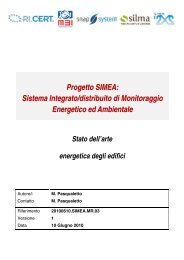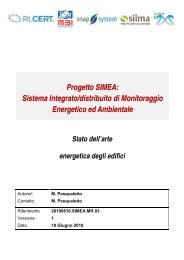Studio di un algoritmo di consensus Newton-Raphson ... - Automatica
Studio di un algoritmo di consensus Newton-Raphson ... - Automatica
Studio di un algoritmo di consensus Newton-Raphson ... - Automatica
Create successful ePaper yourself
Turn your PDF publications into a flip-book with our unique Google optimized e-Paper software.
Algorithm 10 Versione finale dell’<strong>algoritmo</strong> <strong>di</strong>stribuito <strong>di</strong><br />
t<strong>un</strong>ing del parametro ε<br />
<br />
<br />
1: δi(h−τi) = yi(h−τi)<br />
<br />
yi(h−τi−¯τi) <br />
zi(h−τi) − zi(h−τi−¯τi) <br />
<br />
yi(h−τi) <br />
2: δi(h) = − <br />
yi(h)<br />
zi(h)<br />
zi(h−τi)<br />
3: if δi(h−τ) > δi(h) then<br />
4: if εi è stato aumentato precedentemente then<br />
5: ¯εi = εi<br />
6: if εi < 0.5 then<br />
7: εi = 1.5εi<br />
8: else<br />
9: εi = εi +(1−εi)/2.5<br />
10: end if<br />
11: else<br />
12: ∆εi = |¯εi −εi|<br />
13: ¯εi = εi<br />
14: εi = εi +∆εi/2<br />
15: end if<br />
16: τi = τi/2<br />
17: if τi < 1 then<br />
18: τi = 1<br />
19: end if<br />
20: else<br />
21: if ε è stato aumentato precedentemente then<br />
22: ∆εi = |¯εi −εi|<br />
23: ¯εi = εi<br />
24: εi = εi +∆εi/2<br />
25: else<br />
26: εi = εi/2<br />
27: ¯εi = εi<br />
28: end if<br />
29: τi = τi ∗2<br />
30: if τi > τmax then ⊲ non superare il periodo massimo<br />
31: else<br />
32: τi = τmax<br />
33: end if<br />
34: end if<br />
[9] F. Garin, L. Schenato, ”A survey on <strong>di</strong>stributed estimation and control<br />
applications using linear <strong>consensus</strong> algoritmhs”, Networked Control Systems,<br />
Springer, 2011.<br />
[10] F. Girosi, ”An Equivalence Between Sparse Approximation and Support<br />
Vector Machines”, Department of Brain and Cognitive Sciences, Massachusetts<br />
Institute of Technology, 1997.<br />
[11] S.R. G<strong>un</strong>n, ”Support Vector Machines for Classification and Regression”,<br />
Technical Report, Faculty of Engineering and Applied Science,<br />
University of Southampton, 1998.<br />
[12] B. Johansson - ”On <strong>di</strong>stributed optimization in networked systems”,<br />
Ph.D. <strong>di</strong>ssertation, KTH Elettrical Engineering, 2008.<br />
[13] H. K. Khalil, ”Nonlinear Systems (third e<strong>di</strong>tion)”, Prentice Hall, 2002.<br />
[14] J. Lin, E. Elhamifar, I-J. Wang, R. Vidal, ”Consensus with Robustness<br />
to Outliers via Distributed Optimization”, John Hopkins University, Baltimora,<br />
US.<br />
[15] A. Ne<strong>di</strong>ć, D.P. Bertsekas, ”Incremental subgra<strong>di</strong>ents methods for non<strong>di</strong>fferentiable<br />
optimization”, SIAM J. on Optim., Vol.12, No.1, pp.109-138,<br />
2001.<br />
[16] G. Picci, ”Meto<strong>di</strong> statistici per l’identificazione <strong>di</strong> sistemi lineari”,<br />
<strong>di</strong>spensa delle lezioni, 2011.<br />
[17] M. Rabbat, R. Novak, ”Distributed Optimization on Sensor Networks”,<br />
Department of Electrical and Computer Engineering, University of Winsconsin,<br />
2004.<br />
[18] S. S. Ram, A. Ne<strong>di</strong>ć, V. V. Veeravalli, ”Incremental Stochastic Subgra<strong>di</strong>ent<br />
Algorithms for Convex Optimization”, SIAM J. on Optim., Vol.20,<br />
No.2, pp.691-717, 2009.<br />
[19] W. Ren, R. Beard, ”Distributed Consensus in Multi-vehicle Cooperative<br />
Control, Theory and Applications”, Springer, 2008.

















